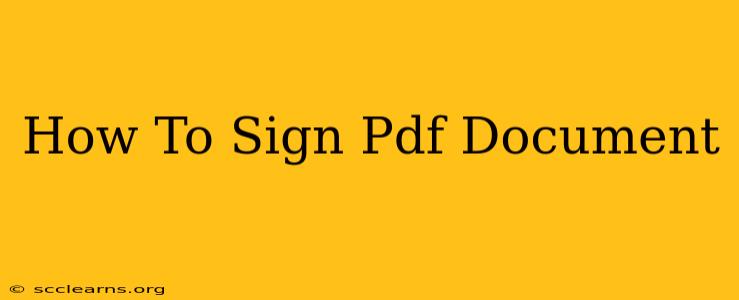Signing a PDF document has become a crucial part of our digital lives. Whether it's a contract, a form, or an important agreement, knowing how to sign a PDF securely and efficiently is essential. This comprehensive guide will walk you through various methods, from simple digital signatures to more secure, legally-binding options.
Methods for Signing PDF Documents
There are several ways to add your signature to a PDF file, each offering varying levels of security and convenience. The best method for you will depend on your specific needs and the level of formality required.
1. Using a Digital Signature App
Many apps specialize in creating and managing digital signatures. These apps often offer features like:
- Multiple signature styles: Create handwritten signatures, typed signatures, or use pre-made templates.
- Security features: Employ encryption and other security measures to protect your signature and the document.
- Integration with other services: Easily integrate with cloud storage services like Dropbox or Google Drive.
- Legal compliance: Some apps provide signatures that meet legal requirements for certain jurisdictions.
Popular Digital Signature Apps: While we won't link directly to specific apps, a quick online search for "digital signature apps" will reveal many options, both free and paid, available on various platforms.
2. Utilizing Built-in PDF Reader Features
Several PDF readers include built-in digital signature tools. This is often the most convenient method for quick signatures. Features might include:
- Signature creation: Create a signature by drawing it on the screen or uploading an image of your handwritten signature.
- Signature placement: Easily place your signature on the document where needed.
- Basic security: Offers a level of security but might not be sufficient for high-security documents.
Examples: Adobe Acrobat Reader (often requires a paid subscription for full functionality), some versions of Preview (on macOS), and other PDF readers might include these capabilities. Check your PDF reader's features to determine if it offers this functionality.
3. Using a Web-Based Signature Tool
Many online tools allow you to sign PDFs directly in your web browser without needing to install any software. These are often a convenient option for quick signatures.
Advantages:
- Accessibility: Access from any device with a web browser.
- Ease of use: Generally simple and user-friendly interfaces.
- Collaboration: Some tools allow for easy sharing and collaboration on documents.
Caveats: Always ensure that the website uses secure protocols (HTTPS) to protect your data and signature.
4. Handwritten Signature and Scanning
This traditional method involves signing a paper copy, then scanning it to create a digital image. While simple, it lacks the security and legal standing of a digital signature.
Best for: Informal documents or situations where a digital signature is not strictly required.
Choosing the Right Method for Your Needs
The best method for signing a PDF depends on your circumstances:
- Legal requirements: For legally binding documents, consider using a digital signature app that meets legal requirements in your jurisdiction.
- Security needs: For highly sensitive documents, choose a method with strong security features.
- Convenience: For quick and informal signatures, using a built-in PDF reader tool or a web-based solution might suffice.
Tips for Secure PDF Signing
- Strong passwords: If your software allows it, use strong, unique passwords to protect your signatures and documents.
- Regular updates: Keep your software and apps updated to benefit from the latest security patches.
- Verification: Always verify the authenticity of the software or website you use for signing.
- Awareness: Be aware of phishing scams and avoid clicking suspicious links or downloading files from untrusted sources.
By understanding the different methods and taking necessary precautions, you can confidently and securely sign your PDF documents. Remember to choose the method that best fits your specific needs and prioritize security whenever dealing with important or sensitive information.

